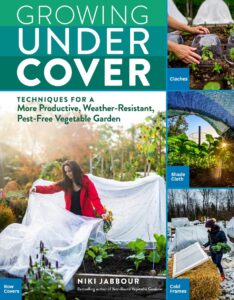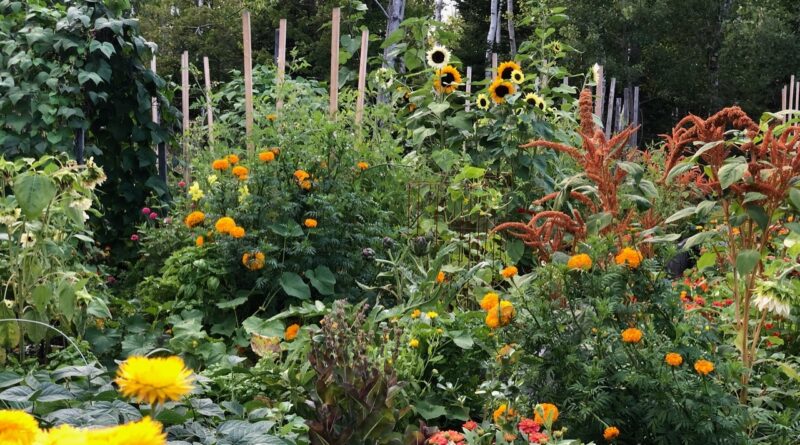Growing Under Cover with Niki Jabbour
Podcast: Play in new window | Download (Duration: 1:58:01 — 55.8MB)
Subscribe: Apple Podcasts | Spotify | Android | iHeartRadio | Podchaser | Email | TuneIn | RSS | More
(November 29, 2020) I’ve come to the conclusion that this is the year of gardening books. Okay, on this show, every year is the year of gardening books. But if you’re one of the 20 million or so Americans who are reported to have started gardening this year, it’s my job to steer you in the right direction. A few weeks ago, we talked to Dr. Allan Armitage about the recently released Herbaceous Perennial Plants, 4th Edition. If you’re learning about gardening, that’s a book you should have. Here’s another, Growing Under Cover: Techniques for a More Productive, Weather-Resistant, Pest-Free Vegetable Garden, by Niki Jabbour.
Skip to a specific segment in this podcast
5:13 Author and gardening expert Niki Jabbour
1:02:00 Executive Director Sean Ruane of Advocates for Urban Agriculture
1:33:26 Meteorologist Rick DiMaio
The best I can remember, Jabbour was last on our show eight years and three radio stations ago. That’s way too long between visits. At the time, she had just written The Year Round Vegetable Gardener, which won the 2012 American Horticultural Society Book Award. Because she is the host of The Weekend Gardener on News 95.7 in Halifax, Nova Scotia, we did a simulcast of our two programs. But that’s way too much work. Besides, I no longer have a radio show, so today she’ll just be our guest.
By the way, Jabbour is also author of Niki Jabbour’s Veggie Garden Remix and Groundbreaking Food Gardens. Her work is found in Fine Gardening, Garden Making, Birds & Blooms, Horticulture, and other publications, and she speaks widely on food gardening at events and shows across North America. She also contributes to the Savvy Gardening blog.
Jabbour’s goal in Growing Under Cover is to introduce you to solutions like cloches, row covers, shade cloth, cold frames, greenhouses and polytunnels for protecting and growing your own food. But like all good books about gardening, she can’t help teaching you a little bit about everything. So, regardless if you can actually put a polytunnel in your yard (I don’t have the right space), this book will make you a better gardener in many ways.
She starts with the Eight Reasons to Become an Under Cover Gardener.
 GROW MORE FOOD. We all want to be as efficient and grow as much food as possible in our gardens; using covers and covered structures will allow you to do just that.
GROW MORE FOOD. We all want to be as efficient and grow as much food as possible in our gardens; using covers and covered structures will allow you to do just that.- CONTROL THE ENVIRONMENT. Depending on the crop, your vegetables can be susceptible to heat, cold, wind, hail, snow, and other environmental conditions. Using covers or structures to create microclimates aids in preventing damage and maintaining crop quality.
- HARVEST YEAR-ROUND. Being able to provide homegrown food for my family 365 days a year is something that I’m proud to brag about. But the truth is that it’s not that hard. Covers allow me to harvest sooner in spring, later in fall, and throughout the winter.
- SAVE MONEY. Like most gardeners, I’m budget minded and don’t like wasting money — or food! Because growing under cover helps me increase yields and enjoy a year-round harvest, I’m shaving serious dollars off my weekly grocery budget.
- REAP A HYPERLOCAL HARVEST. Moving food around the world creates an incredible amount of greenhouse gas emissions. If I go to my supermarket any month of the year, there’s a good chance that the plastic tub of lettuce has been shipped to my Nova Scotia grocery store from California. By growing it myself, I’m cutting the distance our food has travelled from thousands of miles to mere feet.
- REDUCE PEST PROBLEMS. I’m not going to say you won’t have any pest problems (let’s be realistic), but you will have fewer pest problems when you use certain covers. Insect barriers, row covers, deer fencing, deep mulching, cold frames, and polytunnels are simple covers that can prevent insect and animal pests from eating your vegetables.
- GROW THE WORLD. Using season-extending covers like mini hoop tunnels and polytunnels has allowed me to grow a wide variety of global vegetables like edible gourds and cucumber melons that are normally difficult to grow in a short-season region.
- DIY YOUR WAY TO MORE FOOD. Some of the more serious structures, like geodesic domes, polytunnels, and greenhouses significantly increase the amount of food you can grow, but they can be expensive to buy. However, handy gardeners will find that they can DIY many structures using commonly found materials like lumber, PVC conduit, polycarbonate, and polyethylene.
From there, she walks you through the various types of structures you can utilize and the materials needed to construct them. Ah, but she’s just getting started. She then walks you through how set up your garden and its systems, and how to deal with pests, diseases and poor pollination (a lot of the garden is, after all, under covers of one kind or another).
But wait! There’s more!
In Part 2: Vegetables That Love a Cover, she lists your favorite (and not so favorite) vegetables and how to grow them properly, under and outside of the covers. Here’s the list: Artichoke, Arugula, Beans, Beets, Broccoli & Cauliflower, Cabbage & Chinese Cabbage, Carrots, Celery & Celeriac, Cucumbers, Eggplant, Endive, Fennel, Kale & Collards, Lettuce, Melons & Watermelons, Parsnips, Peas, Peppers, Radishes & Turnips, Scallions, Spinach, Squash, Swiss Chard and
Tomatoes.
Whether you’re one of the 20 million who have discovered, during the pandemic, just how important growing your own food is, or you’re looking to up your game, you’ll learn something from Growing Under Cover.
And in case it hasn’t occurred to you yet, it will make a fabulous holiday gift.
Grown in Chicago from AUA
For the month of November, our friends at Advocates for Urban Agriculture have been running a campaign called “Grown in Chicago.” The idea is to support AUA’s new programs, all designed by and for Chicago’s urban agriculture community.
Here are some of programs launched in 2020 by AUA.
- Farmer to Farmer Mentorship Program
- COVID-19 Farmer Support Grant, granting over $120,000 to urban farms and community gardens.
- Grown In Chicago Online Assessment Tool for urban farms.
- Capacity Building Grant, designed to help urban farm businesses scale up their operations and expand programming efforts.
Giving Tuesday happens in two days. But if you want to be part of the “Grown in Chicago” campaign, you need to act by the end of Monday. For every $25 you contribute, you will have one raffle ticket entered into the pot, giving you a chance to win some pretty nifty raffle items. To see what’s available, click here.
Meanwhile, AUA Executive Director Sean Ruane joins us on today’s show to talk about the campaign. We also hope to highlight other ways that folks can make this a special holiday season by helping others in need. Yes, we know that happens a lot during the holidays, and that’s a good thing.
However, there are a lot more people suffering this year, thanks to the pandemic and the resulting economic downturn. (Ignore the stock market. It has nothing to do with people’s lives.) Perhaps we’ll have an idea or two that will resonate with you and help you focus on others. Or focus on the planet. Or focus on something other than the usual conspicuous consumption that we’re so famous for. It’s something to think about anyway.

